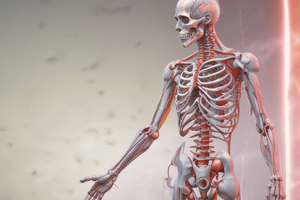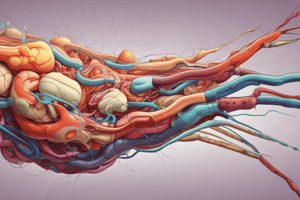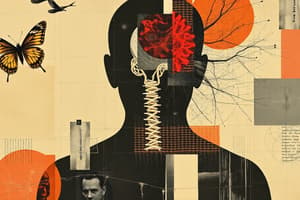Podcast
Questions and Answers
Which chemical mediators are released during tissue damage?
Which chemical mediators are released during tissue damage?
- Norepinephrine and acetylcholine
- Prostaglandins and serotonin (correct)
- Dopamine and cortisol
- Endorphins and enkephalins
What is the first process activated after tissue damage occurs?
What is the first process activated after tissue damage occurs?
- Perception
- Transmission
- Modulation
- Transduction (correct)
Where does the action potential travel after leaving the site of injury?
Where does the action potential travel after leaving the site of injury?
- Along afferent nerve fibers to the spinal cord (correct)
- To the limbic system
- To the brain stem
- Directly to the somatosensory cortex
Which neurotransmitters facilitate the transmission of pain at the spinal cord level?
Which neurotransmitters facilitate the transmission of pain at the spinal cord level?
Which part of the brain first processes nociceptive messages coming from the thalamus?
Which part of the brain first processes nociceptive messages coming from the thalamus?
What role do endorphins, enkephalins, and serotonin play in pain modulation?
What role do endorphins, enkephalins, and serotonin play in pain modulation?
What is the effect of inflammatory mediators on the body's thermostat?
What is the effect of inflammatory mediators on the body's thermostat?
In the context of pain perception, which statement correctly describes modulation?
In the context of pain perception, which statement correctly describes modulation?
What is the primary reason that people seek healthcare related to pain?
What is the primary reason that people seek healthcare related to pain?
What type of pain involves activation by tissue damage and inflammation?
What type of pain involves activation by tissue damage and inflammation?
Which of the following processes is NOT part of nociception?
Which of the following processes is NOT part of nociception?
What does neuropathic pain mainly involve?
What does neuropathic pain mainly involve?
Why is individual assessment crucial in pain management?
Why is individual assessment crucial in pain management?
What aspect of pain does modulation refer to?
What aspect of pain does modulation refer to?
What does transduction in nociception refer to?
What does transduction in nociception refer to?
What is the effect of not managing pain properly?
What is the effect of not managing pain properly?
What causes an increase in the thermostat set-point in the body?
What causes an increase in the thermostat set-point in the body?
What happens when the actual body temperature is lower than the new set-point?
What happens when the actual body temperature is lower than the new set-point?
What is likely to happen during the 'breaking' of a fever?
What is likely to happen during the 'breaking' of a fever?
What role do interleukins play in fever development?
What role do interleukins play in fever development?
How does the body feel when the set-point raises to 103°F?
How does the body feel when the set-point raises to 103°F?
What is the consequence of healing tissue cells stopping the release of pyrogens?
What is the consequence of healing tissue cells stopping the release of pyrogens?
What mechanism does the body use to induce sweating during a fever?
What mechanism does the body use to induce sweating during a fever?
Why might a fever be more dangerous for the elderly?
Why might a fever be more dangerous for the elderly?
Flashcards are hidden until you start studying
Study Notes
Introduction to Pain
- Pain is a common reason for seeking healthcare.
- Pain is unpleasant and usually indicates tissue damage.
- Effective pain management improves quality of life.
- Each individual perceives pain differently.
Types of Pain
- Nociceptive pain involves the normal neural processing of pain triggered by tissue damage or inflammation.
- Neuropathic pain involves abnormal processing of stimuli in the peripheral or central nervous system, potentially serving no useful purpose. It can be caused by damage to peripheral nerves or the spinal cord.
Nociceptive Pain
- Nociception involves four distinct steps: transduction, transmission, perception, and modulation.
- Transduction: Chemical mediators like prostaglandins, bradykinins, serotonin, substance P, and histamine are released from damaged tissue.
- Transmission: Action potential moves from the injury site along afferent nerve fibers to nociceptors in the spinal cord.
- Perception: Conscious experience of pain involving both sensory and affective components.
- Modulation: Activation of the midbrain triggers the release of neurotransmitters like endorphins, enkephalins, serotonin, and dynorphin, which inhibit pain impulse transmission at the dorsal horn.
Fever
- Fever is part of the inflammatory process.
- Increased body temperature is related to the body's thermostat.
- Fever is caused by the release of inflammatory mediators.
Temperature Control
- Inflammatory mediators released from injured cells enter the bloodstream and reach the brain, raising the thermoregulatory set point.
- Leukocytic pyrogen and prostaglandins act on hypothalamic neurons, causing an increase in the set point.
- The body then works to reach this new, higher set point, resulting in a fever.
Getting a Fever
- Interleukins and prostaglandins raise the set point.
- The greater the injury, the more chemicals are released, leading to a higher set point.
- If the body's actual temperature is below the new set point, the thermoregulatory reflex center activates mechanisms to increase body temperature, causing a fever.
Breaking a Fever
- Healing tissue cells stop releasing chemicals, returning the set point to normal.
- Cooling mechanisms activate to return the body temperature to the normal set point.
- These mechanisms include sweating, blood vessel dilation, and a feeling of being hot.
Studying That Suits You
Use AI to generate personalized quizzes and flashcards to suit your learning preferences.




